A Ni-Doped Carbon Nanotube Sensor for Detecting Oil-Dissolved Gases in Transformers
Abstract
:1. Introduction
2. Experimental Section
2.1. Preparation of the Ni-CNT Sensor

2.2. Sensor Response Experiment
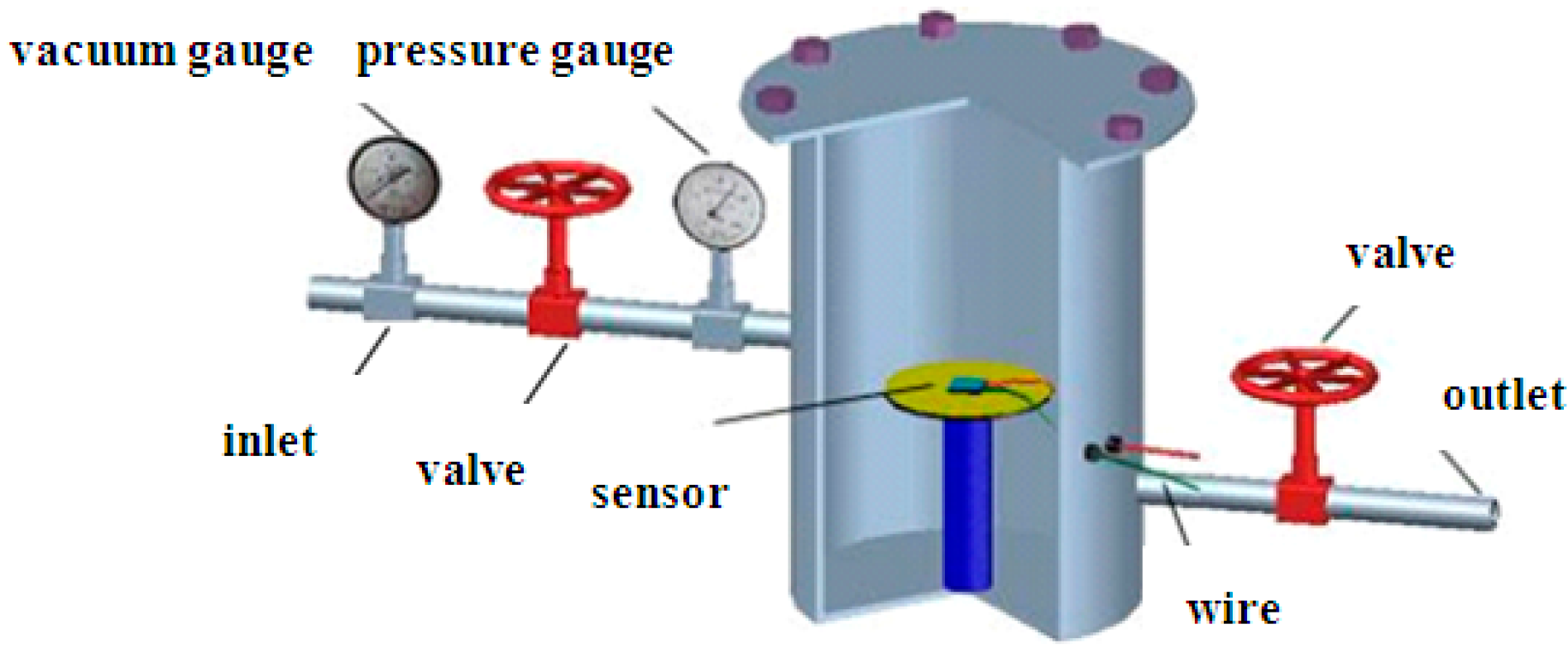
2.3. Experiment Result and Discussion
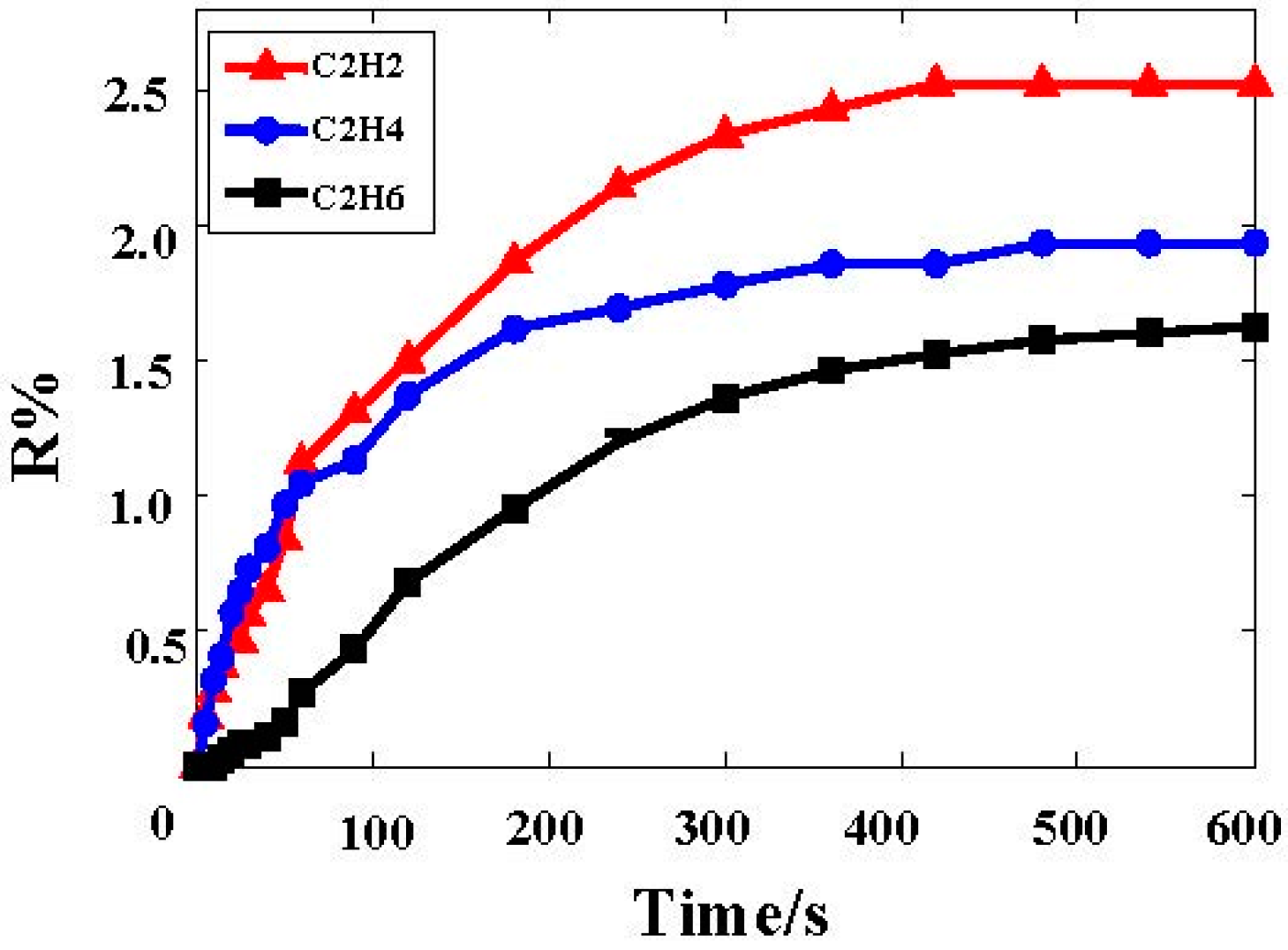
2.4. Sensor Response of Different C2H2 Concentrations
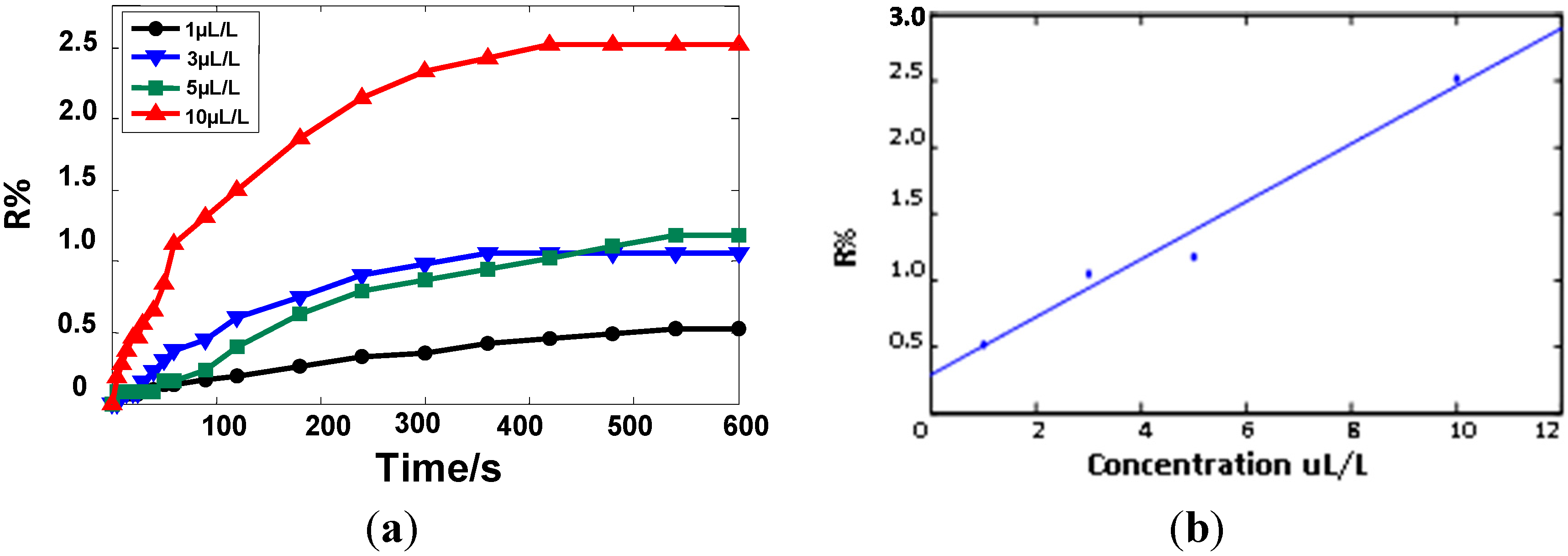
2.5. Reproducibility of Ni-Doped CNTs
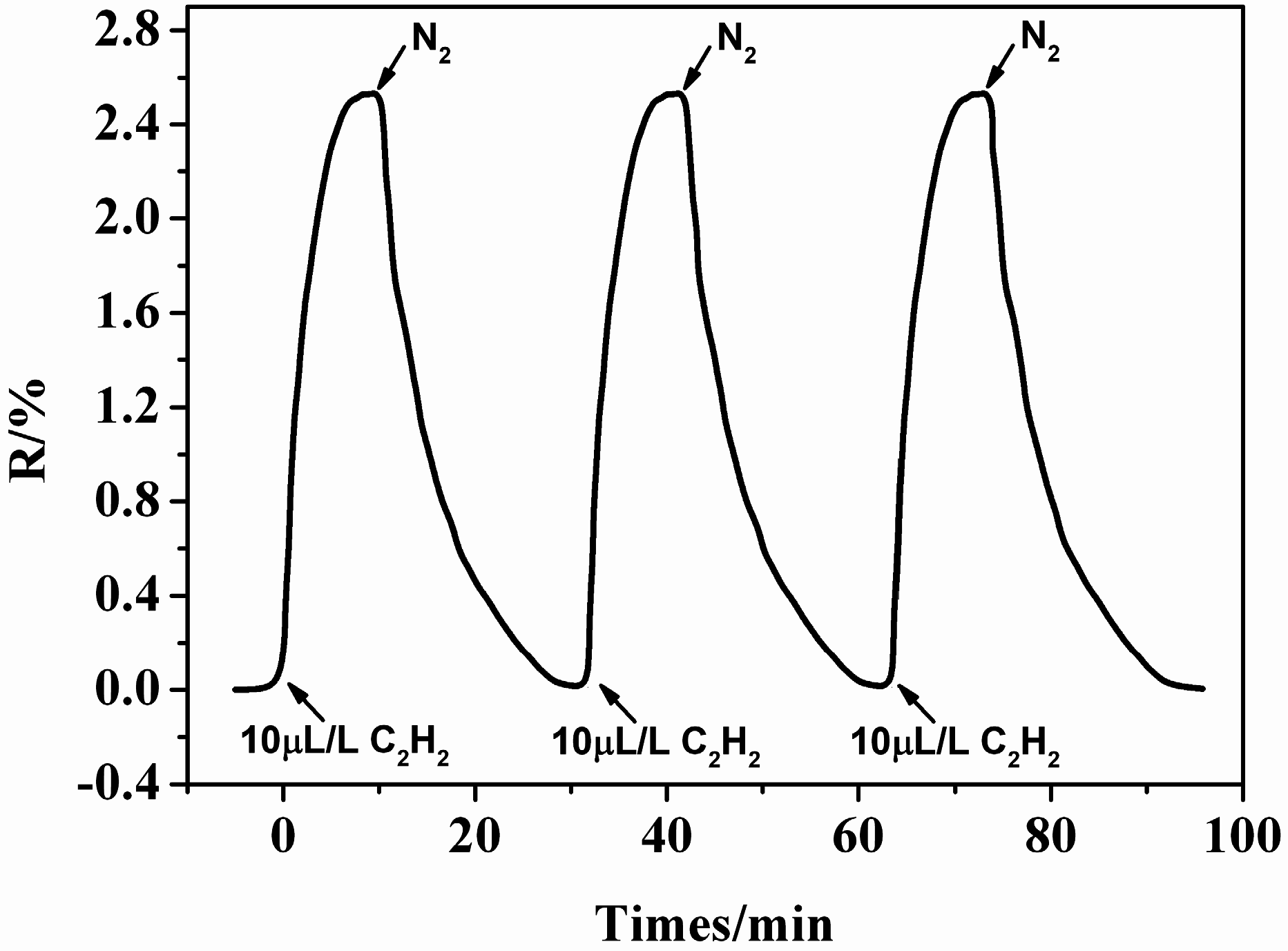
3. Theoretical Calculations
3.1. Computational Details
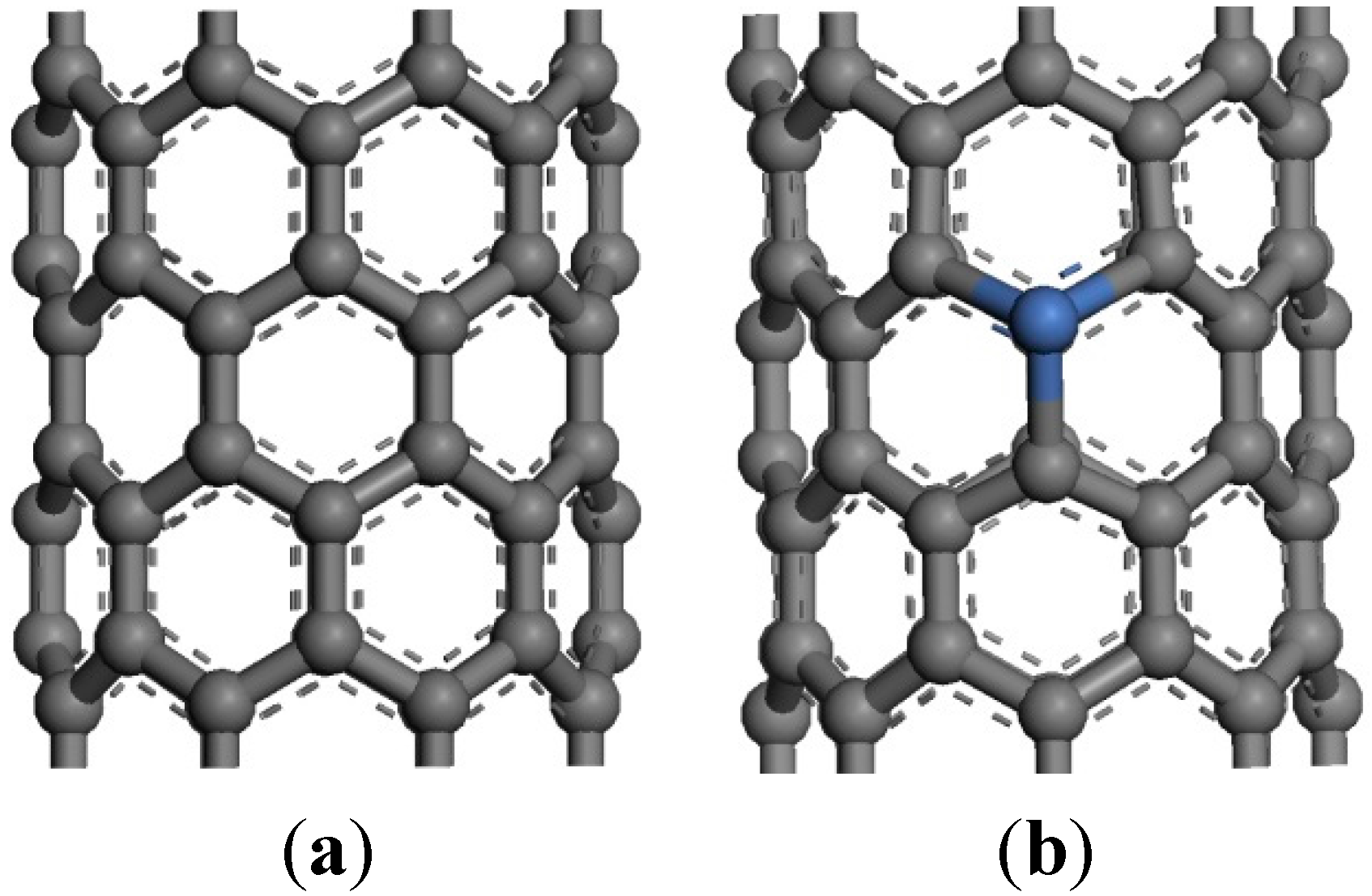
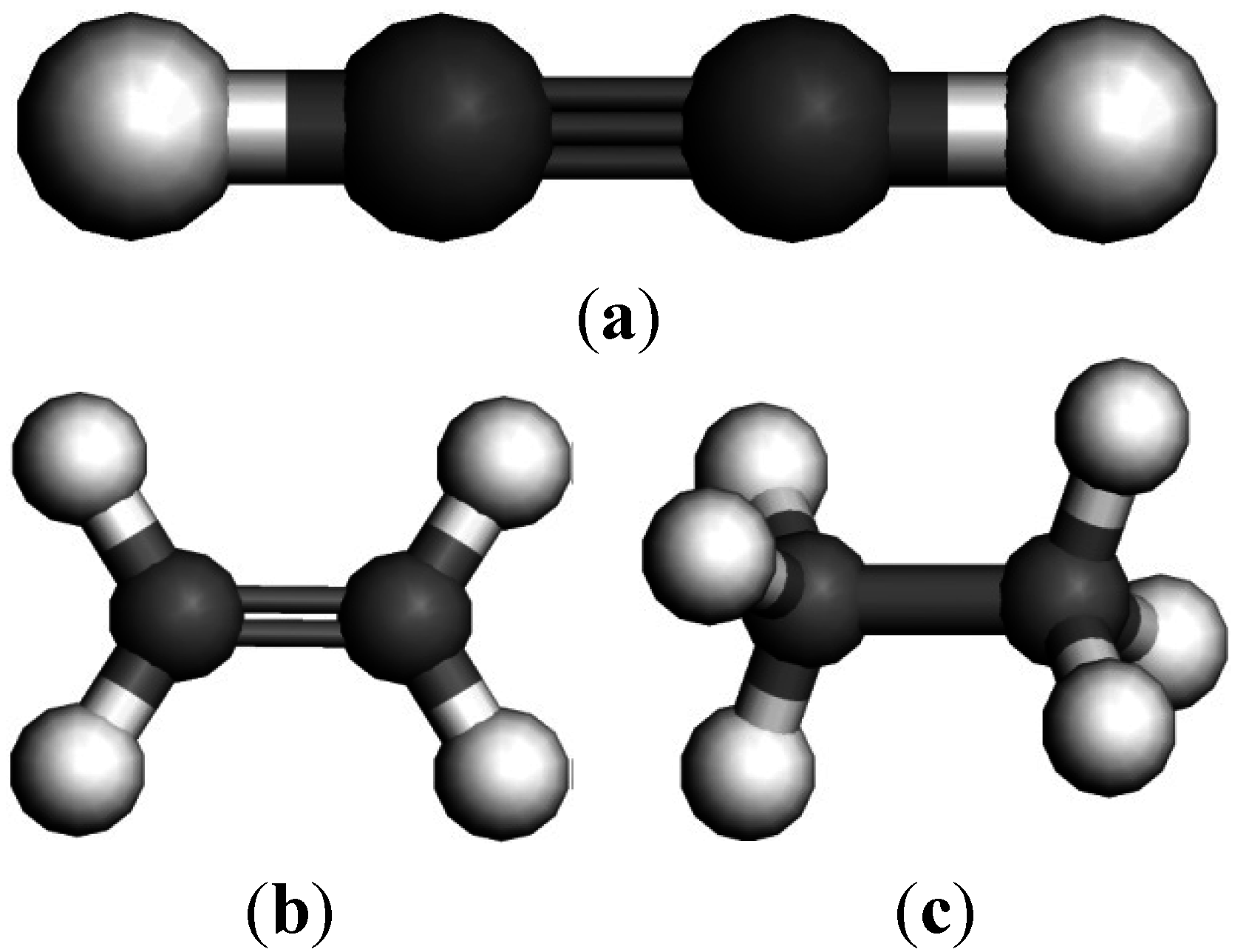
3.2. Results and Discussion
3.2.1. Adsorption Energy and Charge Transfer
| Eads (eV) | QT (e) | |
|---|---|---|
| C2H2-CNTs | −0.3265 | 0.006 |
| C2H4-CNTs | −0.2814 | 0.003 |
| C2H6-CNTs | −0.0458 | 0.002 |
| C2H2-Ni-CNTs | −1.7412 | 0.091 |
| C2H4-Ni-CNTs | −0.9246 | 0.069 |
| C2H6-Ni-CNTs | −0.1994 | 0.043 |
3.2.2. Frontier Molecular Orbital Analysis
| EHOMO (eV) | ELUMO (eV) | EL-H (eV) | |
|---|---|---|---|
| CNTs | −4.5606 | −3.8695 | 0.6911 |
| Ni-CNTs | −4.9797 | −4.4327 | 0.5470 |
| C2H2–Ni-CNTs | −4.5906 | −4.1606 | 0.4300 |
| C2H4–Ni-CNTs | −4.6940 | −4.2477 | 0.4463 |
| C2H6–Ni-CNTs | −4.7593 | −4.1933 | 0.5660 |
4. Analysis of Experimental and Theoretical Results
5. Conclusions
- (1)
- The gases C2H2, C2H4, and C2H6 can be physically adsorbed on intrinsic carbon nanotubes, and the adsorption sensitivity is as follows: C2H2 > C2H4 > C2H6.
- (2)
- Ni doped CNTs minimize the energy level difference and boost the conductivity of the CNTs. The adsorptions of the three gases became stronger, and the adsorption sensitivity of the Ni-CNTs was consistent with that of the CNTs.
- (3)
- The surface active sites of the CNTs increased and catalytic activity was greatly enhanced because of the coordination unsaturation of the nickel ion surface atoms. The doped Ni improved the ability of the tube to adsorb gas molecules.
- (4)
- When detecting low C2H2 concentrations (1 µL/L to 10 µL/L), the relative variation of the sensor resistance R% and the gas concentration meet a certain linear relationship, which indicates that the developed sensor can detect low gas concentrations.
Acknowledgments
Author Contributions
Conflicts of Interest
References
- Iijinma, S. Helical microtubules of graphitic carbon. Nature 1991, 354, 56–58. [Google Scholar] [CrossRef]
- Niyogi, S.; Hamon, M.A.; Hu, H.; Zhao, B.; Bhowmik, P.; Sen, R.; Itkis, M.E.; Haddon, R.C. Chemistry of Single-Walled Carbon Nanotubes. Acc. Chem. Res. 2002, 35, 1105–1113. [Google Scholar] [CrossRef] [PubMed]
- Zhang, X.; Yang, B.; Wang, X.; Luo, C. Effect of Plasma Treatment on Multi-Walled Carbon Nanotubes for the Detection of H2S and SO2. Sensors 2012, 12, 9375–9385. [Google Scholar] [CrossRef] [PubMed]
- Kong, J.; Franklin, N.R.; Zhou, C.; Chapline, M.G.; Peng, S.; Cho, K.; Dai, H. Nanotube Molecular Wires as Chemical Sensors. Science 2000, 287, 622–625. [Google Scholar] [CrossRef] [PubMed]
- Zhao, J.; Buldum, A.; Han, J.; Lu, J.P. Gas Molecule Adsorption in Carbon Nanotubes and Nanotube Bundles. Nanotechnology 2002, 13, 195–200. [Google Scholar] [CrossRef]
- Durgun, E.; Dag, S.; Bagci, V.M.K.; Gülseren, O.; Yildirim, T.; Ciraci, S. Systematic study of adsorption of single atoms on a carbon nanotube. Phys. Rev. B 2003, 67, 201401. [Google Scholar] [CrossRef]
- Li, J.; Lu, Y.; Ye, Q.; Cinke, M.; Han, J.; Meyyappan, M. Carbon Nanotube Sensors for Gas and Organic Vapor Detection. Nano Lett. 2003, 3, 929–933. [Google Scholar] [CrossRef]
- Novak, J.P.; Snow, E.S.; Houser, E.J.; Park, D.; Stepnowski, J.L.; McGill, R.A. Nerve agent detection using networks of single-walled carbon nanotubes. Appl. Phys. Lett. 2003, 83, 4026–4028. [Google Scholar] [CrossRef]
- Chen, C.; Wang, X. Adsorption of Ni(II) from aqueous solution using oxidized multiwall carbon nanotubes. Ind. Eng. Chem. Res. 2006, 45, 9144–9149. [Google Scholar] [CrossRef]
- Wang, R.; Zhang, D.; Sun, W.; Han, Z.; Liu, C. A novel aluminum-doped carbon nanotubes sensor for carbon monoxide. J. Mol. Struct. THEOCHEM 2007, 806, 93–97. [Google Scholar] [CrossRef]
- Kang, H.; Lim, S.; Park, N.; Chun, K.Y.; Baik, S. Improving the sensitivity of carbon nanotube sensors by benzene functionalization. Sens. Actuators B Chem. 2010, 147, 316–321. [Google Scholar] [CrossRef]
- Zhang, X.; Liu, W.; Tang, J.; Xiao, P. Study on PD Detection in SF6 using Multi-wall Carbon Nanotube Films Sensor. IEEE Trans. Dielectr. Electr. Insul. 2010, 16, 206–213. [Google Scholar] [CrossRef]
- Inoue, Y.; Suganuma, K.; Kamba, M. Development of oil-dissolved hydrogen gas detector for diagnosis. IEEE Trans. Power Deliv. 1990, 5, 226–232. [Google Scholar] [CrossRef]
- Huang, Y.C. Condition assessment of power transformers using genetic-based neural networks. IEE Proc. Sci. Meas. Technol. 2003, 150, 19–24. [Google Scholar] [CrossRef]
- Arakelian, V.G. The long way to the automatic chromatographic analysis of gases dissolved in insulating oil. IEEE Electr. Insul. Mag. 2004, 20, 8–25. [Google Scholar] [CrossRef]
- Goldstein, N.Y.; Grover, B.; Chang, C.; Jelli, A.; Andre, J.; Mark, P.; Goodwin, A. A gas chromatographic air analyzer fabricated on a silicon wafer. IEEE Trans. Electron. Devices 1979, 26, 1880–1886. [Google Scholar]
- Chen, W.G.; Gao, T.Y.; Li, Q.Z.; Gan, H.I. Enhanced gas sensing properties of flower-like ZnO nanostructure to acetylene. Adv. Perform. Mater. 2015, 30, 96–100. [Google Scholar] [CrossRef]
- Chen, W.G.; Gan, H.L.; Zhang, W.; Mao, Z.Y. Hydrothermal Synthesis and Hydrogen sensing properties of nanostructured SnO2 with different morphologies. J. Nanomater. 2014, 2014, 1–7. [Google Scholar]
- Zhao, N.Q.; Cui, Q.R.; He, C.N.; Shi, C.S. Synthesis of carbon nanostructures with different morphologies by CVD of methane. Mater. Sci. Eng. A 2007, 460–461, 255–260. [Google Scholar] [CrossRef]
- DL/T 722–2000. Analysis and Judgment Guidance of Gases Dissolved in the Transformer Oil, 2000. Available online: http://www.51zbz.com/biaozhun/45199.html (accessed on 8 June 2015). (In Chinese)
- Perdew, J.P.; Burke, K.; Ernzerhof, M. Generalized Gradient Approximation Made Simple. Phys. Rev. Lett. 1996, 77, 3865–3868. [Google Scholar] [CrossRef] [PubMed]
- Peng, S.; Cho, K. Ab Initio Study of Doped Carbon Nanotube Sensors. Nano Lett. 2003, 3, 513–517. [Google Scholar] [CrossRef]
- Qi, P.; Vermesh, O.; Grecu, M.; Javey, A.; Wang, Q.; Dai, H. Toward Large Arrays of Multiplex Functionalized Carbon Nanotube Sensors for Highly Sensitive and Selective Molecular Detection. Nano Lett. 2003, 3, 347–351. [Google Scholar] [CrossRef]
- Fukui, K.; Yonezawa, T.; Shingu, H. A Molecular Orbital Theory of Reactivity in Aromatic Hydrocarbons. J. Chem. Phys. 1952, 20, 722–725. [Google Scholar] [CrossRef]
- Fleming, I. Frontier Orbitals and Organic Chemical Reactions; Wiley: London, UK; New York, NY, USA, 1976. [Google Scholar]
- Kim, S.J.; Park, Y.J.; Ra, E.J.; Kim, K.K.; An, K.H.; Lee, Y.H.; Choi, J.Y.; Park, C.H.; Doo, S.K.; Park, M.H.; et al. Defect-induced loading of Pt nanoparticles on carbon nanotubes. Appl. Phys. Lett. 2007, 90. [Google Scholar] [CrossRef]
- Pannopard, P.; Khongpracha, P.; Probstc, M.; Limtrakul, J. Gas sensing properties of platinum derivatives of single-walled carbon nanotubes: A DFT analysis. J. Mol. Graph. Model. 2009, 28, 62–69. [Google Scholar] [CrossRef] [PubMed]
- Chen, P.; Wu, X.; Lin, J.; Tan, K.L. Synthesis of Cu Nanoparticles and Microsized Fibers by Using Carbon Nanotubes as a Template. Phys. Chem. B 1999, 103, 4559–4561. [Google Scholar] [CrossRef]
- Collins, P.G.; Bradley, K.; Ishigami, M.; Zettl, A. Extreme Oxygen Sensitivity of Electronic Properties of Carbon Nanotubes. Science 2000, 287, 1801–1804. [Google Scholar] [CrossRef] [PubMed]
- Li, Y.H.; Wang, S.; Wei, J.; Zhang, X.; Xu, C.; Luan, Z.; Wu, D.; Wei, B. Lead Adsorption on Carbon Nanotubes. Chem. Phys. Lett. 2002, 357, 263–266. [Google Scholar] [CrossRef]
© 2015 by the authors; licensee MDPI, Basel, Switzerland. This article is an open access article distributed under the terms and conditions of the Creative Commons Attribution license (http://creativecommons.org/licenses/by/4.0/).
Share and Cite
Lu, J.; Zhang, X.; Wu, X.; Dai, Z.; Zhang, J. A Ni-Doped Carbon Nanotube Sensor for Detecting Oil-Dissolved Gases in Transformers. Sensors 2015, 15, 13522-13532. https://doi.org/10.3390/s150613522
Lu J, Zhang X, Wu X, Dai Z, Zhang J. A Ni-Doped Carbon Nanotube Sensor for Detecting Oil-Dissolved Gases in Transformers. Sensors. 2015; 15(6):13522-13532. https://doi.org/10.3390/s150613522
Chicago/Turabian StyleLu, Jia, Xiaoxing Zhang, Xiaoqing Wu, Ziqiang Dai, and Jinbin Zhang. 2015. "A Ni-Doped Carbon Nanotube Sensor for Detecting Oil-Dissolved Gases in Transformers" Sensors 15, no. 6: 13522-13532. https://doi.org/10.3390/s150613522
APA StyleLu, J., Zhang, X., Wu, X., Dai, Z., & Zhang, J. (2015). A Ni-Doped Carbon Nanotube Sensor for Detecting Oil-Dissolved Gases in Transformers. Sensors, 15(6), 13522-13532. https://doi.org/10.3390/s150613522






